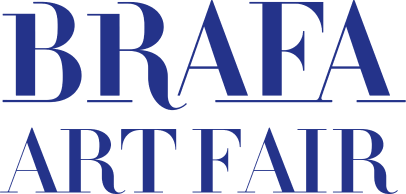This section will be available this Autumn.

Samuel Vanhoegaerden Gallery
Bram Bogart (Delft 1921-2012 Sint Truiden) Topgroen, August 1963 Mixed media on canvas laid on wooden panel 161 x 201 cm Signed, dated and titled on reverse Provenance: private collection, London In August 1963, Bram Bogart created a powerful and iconic work: Topgroen (August 1963). The painting – executed with homemade paint on a board/canvas made by the artist himself – measures approximately 161 x 201 cm and testifies to Bogart's radically innovative approach to matter and colour. The work Topgroen is at the heart of Bogart's most highly regarded period, in which he experimented with imposing layers of paint, sculptural reliefs and a colour palette that transcends the surface and becomes almost tangible. In this work, he combines powerful fields of colour with monumental texture: an intense red surface is directly framed by thick, almost architecturally shaped green and yellow accents. The paint is hardly imagination anymore, but matter – as if the paint itself is the object. Topgroen marks a turning point in Bogart's oeuvre: colour and volume become one, the painting resists classical painting through an enormous physical presence of the matter. The work invites tactile viewing: the depth of the paint layers, the shadow effects between reliefs, and the tension between surface and volume make it a masterpiece of material painting. Bogart thus confirms his pioneering role in European post-war abstraction.
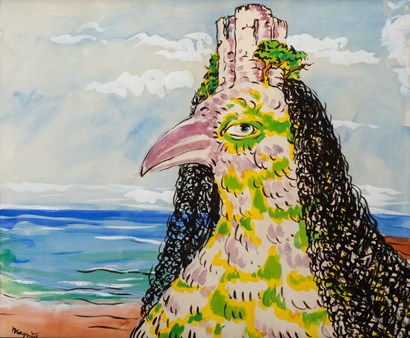
Virginie Devillez Fine Art
rené magritte
René Magritte (Lessines 1898-1967 Brussels) Le Prince charmant, 1948 Gouache on paper 37 x 46 cm Signed lower left 'Magritte' Provenance: Willy van Hove-Cuche, Brussels; private collection; Galerie Motte, Genève (auction 7 December 1973, lot 30); Margaret Krebs, Brussels; Christie’s, London (auction 27 June 1978, lot 145); Sotheby’s, London (auction 6 February 2001, lot 157); Beaux-Arts Auction, Brussels (auction 26 April 2005, lot 51); private collection, Belgium Literature: Ronny Van de Velde, René Magritte. Peintures et gouaches, Antwerp, 1994, ill. n. p.; David Sylvester (Ed.), René Magritte – Catalogue Raisonné. IV: Gouaches, Temperas, Watercolours and Papiers Collés 1918-1967, Menil-Foundation/Fonds Mercator, 1994, CR 261 (ill. p. 102); Esther Schlicht & Max Hollein (Éd.), René Magritte 1948. La période vache, Frankfurt, Schirn Kunsthalle, 2008-2009, ill. p. 45; Paris, Galerie du Faubourg, Magritte: peintures et gouaches, 1948, cat. n° 24 ( ? or CR 1260); Rotterdam, Museum Boymans-van Beuningen, René Magritte: het mysterie van de werkelijkheid, 1967, cat. n° 97 (ill. p. 223); Stockholm, Moderna Museet, René Magritte, 1967, cat. n° 50; Paris, Fondation Dina Vierny – Musée Maillol, Magritte tout en papier, 2006, without cat. n° (ill. p. 160); Rotterdam, Museum Boymans-van Beuningen, Voici Magritte. Gouaches, collages, tekeningen, studies, schilderijen, 2006, without cat. n° (ill. p. 160); Paris, Centre Pompidou – Musée national d’Art moderne, Magritte. La Trahison des Images, 2016-2017, without cat. n° (ill. p. 152); Skärhamn, Nordiska Akvarellmuseet, Magritte. A Lab of Ideas. Works on paper, 2022, without cat. n° (ill. p. 135)

Galerie Jean-François Cazeau
kees van dongen
Kees Van Dongen (Rotterdam 1877-1968 Monaco) La Chemise or Femme penchée sur un coussin jaune Oil on canvas 48.5 x 55 cm Signed lower right This work will be included in the forthcoming catalogue raisonné of Kees Van Dongen compiled by the Wildenstein Plattner Institute Provenance: studio of the artist, Paris; private collection, France (Marquise de X); Palais Galliera, 18 May 1964, Paris; Jacques Pignet, Neuilly-sur-Seine, France; Galerie Koller, Zurich, November 1981; Paul Petridès, Paris, France Ader-Picard-Tajan, 25 June 1987, Paris; acquired by the current owner at the above sale Exhibitions: Paris, Galerie de Paris, La Cage aux Fauves, Salon d'Automne, 1905; Paris, Musée National d'Art Moderne, Van Dongen, 13 October-26 November 1967, n° 68; Rotterdam, Museum Boymans van Beuningen, Van Dongen, 8 December 1967-28 January, n° 20; Monaco, Nouveau Musée de Monaco, Kees Van Dongen, 25 June-7 September 2008, n° 139
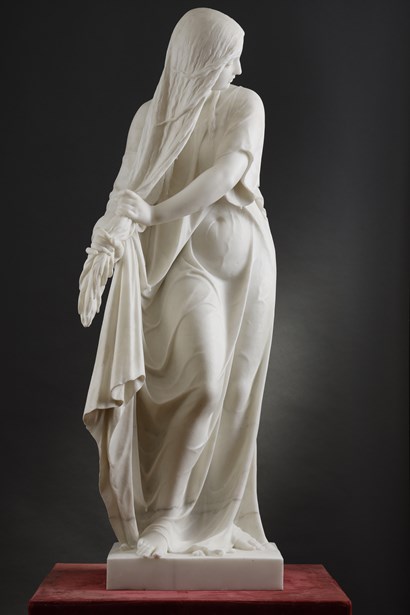
Artimo Fine Arts
charles-auguste fraikin
Charles-Auguste Fraikin (Herentals 1817-1893 Brussels) Emerging from the Sea Bath White Carrara marble H 123 x W 37 x D 33 cm Provenance: Francis Meyer collection, Switzerland Literature: Fraikin, Charles-Auguste. Catalogue de la galerie. Musée Fraikin de Herenthals offert par l'artiste à sa ville natale l'an 1891. Herentals: Typ. L. Bongaerts-Verbeeck, 1891; Engelen & Marx. La sculpture en Belgique à partir de 1830. Tome III: Devreese-Hecq. Bruxelles : Éditions Ars 2006, pp. 1550-1557 With this work, Charles-Auguste Fraikin celebrates feminine beauty captured in the intimacy of a daily gesture: that modest and natural act of a young woman emerging from the water and wringing out her long hair. The sculptor excels here in the art of suggestion rather than revelation. The delicately fitted drapery clings to the body’s contours whilst gracefully concealing them, playing on the translucency of the marble and the softness of the volumes. The work bears witness to the dual influence of classical ideals and the romantic taste for a sensitive evocation of femininity. Through his treatment of surfaces - silken, clean, almost vibrant - Fraikin achieves a remarkable degree of refinement whilst preserving a clear narrative: that of a moment suspended in time, poised between genre scene and allegory. Emerging from the Sea Bath brilliantly illustrates Fraikin’s ability to combine modesty with sensuality, simplicity with virtuosity, in a sculpture that speaks both to the eye and to the imagination.

Galerie Flak
Yipwon hook figure Korewori river, Papua New Guinea, 19th century or earlier (C-14 test) Carved wood H 200 cm Provenance: Merrin Gallery, New York; Californian artist Tony Berlant collection; acquired from the above in the 1980s; Michael Hamson collection, USA; Dr. Jean-Philippe Beaulieu collection, France; acquired from the previous in 2022
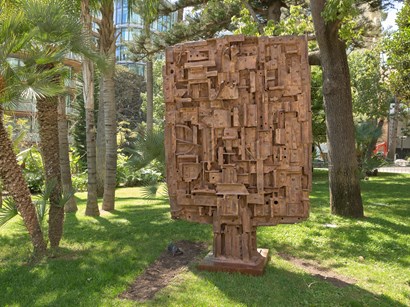
Galerie Patrice Trigano
césar
César, alias César Baldaccini (Marseille 1921-1998 Paris) Hommage à Eiffel, 1989 Welded bronze Bocquel foundry 280 x 200 x 55 cm Signed and numbered Provenance: acquired from the artist in 1990 Literature: P. Restany, César, éd. De la Différence, Paris, 1988, p. 65 and p. 328 (Monumental version of Cartier Foundation, photography in progress); B.-H. Lévy, César, les bronzes, Éditons de la Différence, Galerie Baubourg, Paris, 1991, p. 24; César, Oeuvres de 1947 à 1993, Musée de Marseille, Réunion des Musées Nationaux, Marseille, 1993, p. 159; César, Galerie Enrico Navarra, Paris, 1996, pp. 76-77; César, Museu Brasileiro da Escultura Marilisa Rathsam, Sao Paulo, 1999, p. 212; Paris, Centre Georges Pompidou, César la rétrospective, December 2017- March 2018, p. 173; Archives Denyse Durand-Ruel, n° 4499 Exhibitions: Marseille, centre de la Vieille Charité, César, oeuvres de 1947 à 1993, July-September 1993, p. 159; Monte-Carlo, César à Monte-Carlo, May-September 1993, (unnumbered); Luxembourg, Dexia Banque Internationale, Hommage à César, October-December 2000, p. 70; Cannes, La Malmaison, César, l’oeuvre de bronze, July-October 2002, p. 86; Travelling exhibition: Cannes, parvis du palais des Festivals, July-September 2002; Geneviève, Galerie Artrium, September-December 2002; Rabat, Musée Mohammed VI d’Art Moderne et Contemporain, César, une histoire méditerranéenne, December 2015-March 2016, reproduced in colour p. 68 and p. 70
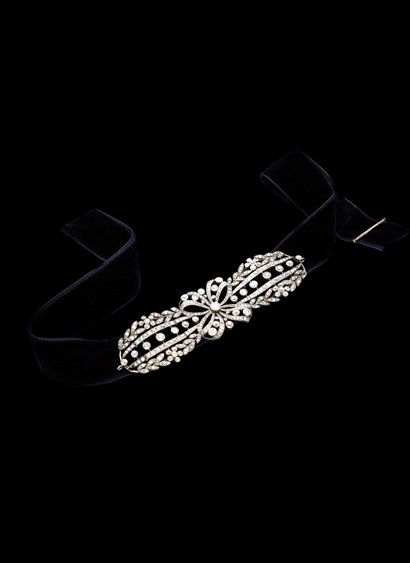
Pauline's Jewellery Box
Belle Epoque diamond tiara necklace, circa 1905 Platinum and diamonds Provenance: private collection, London An important Belle Epoque diamond tiara necklace, set with old European & rose cut diamonds. The estimated total diamond weight is approximately 12.00 carats. Estimated colour H-I on average. Estimated clarity VS-SI on average. The diamonds are bright & lively, mounted in platinum.
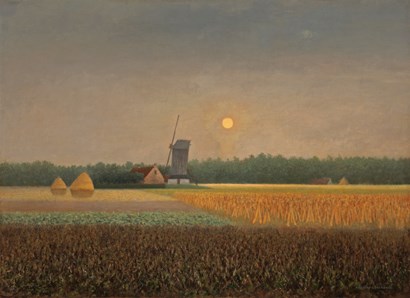
Galerie Oscar De Vos
albijn van den abeele
Albijn Van den Abeele (Sint-Martens-Latem 1835-1918 Aldaar) Last rays of sunshine and rising moon, 1904 Oil on canvas 80.5 x 110.5 cm Signed lower right: Albijn Van den Abeele Provenance: A. Van den Abeele, Sint-Marten-Latem; P. De Rijckere, Ghent; R. Van den Abeele, Sint-Martens-Latem; E. Van den Abeele, Sint-Martens-Latem Literature: Boyens, P., Sint-Martens-Latem. Kunstenaarsdorp in Vlaanderen (1992), 176-177 (ill.); Boyens, P., In de voetsporen van de Latemse kunstenaars (2003), 76-77 (ill.); Devoghelaere, H., Albijn Van den Abeele (1935), 39, 45, no. 33; D'Haese, J. & H. Lampo, Albijn Van den Abeele en de schilders van de Leie (1973), cat. 28 (ill.); Haesaerts, P., Sint-Martens-Latem. Gezegend oord van de Vlaamse kunst (1965), 76 (ill.); Hoozee, R., Veertig kunstenaars rond Karel Van den Woestijne (1979), 43-44, cat. 58 (ill.); Pauwels, H., De eerste groep van Sint-Martens-Latem 1899-1914 (1980), 96, 148, cat. 5 (ill.); Pauwels, P.J.H. & V. Van Doorne, Leie. Rimpeloze eenvoud (2010), 35, 106, cat. 8 (ill.); Van den Abeele, R., Albijn Van den Abeele. De stamvader van de Latemse kunstenaars (1993), 98-99, 135-138, 211, cat. 117 (ill.); Van den Abeele, E. e.a., Albijn Van den Abeele (2019), 34 (ill.); Van Doorne, V. e.a., Retrospectieve tentoonstelling Albijn Van den Abeele (1835-1918) (1985), 98-99, 211, 226, cat. 117 (ill.); Van Doorne, V. e.a., Sint-Martens-Latem - Worpswede 1880-1914. Twee kunstenaarskolonies (1996), 13, 65, 72, cat. 5 (ill.); Van Lerberghe, J., Belgische kunst van 1890-heden (1966), 21, cat. 7 Exhibitions: 1924, Ghent, Kunstgalerij Brabantdam, Albijn van den Abeele, cat. 8; 1966, Utrecht, Centraal Museum, Belgische kunst van 1890 tot heden, cat. 7; 1973, Venlo, Cultureel Centrum, Albijn Van den Abeele en de schilders van de Leie, cat. 28; 1974, Sint-Martens-Latem, Latemse Galerij, Kunstenaars zien Latem, cat. 156; 1976, Brussels, Passage 44, Tentoonstelling Oost-Vlaanderen, s.n.; 1978, Antwerp, AMVC Letterenhuis, Karel Van de Woestyne, s.n.; 1979, Brussels, Koninklijke Bibliotheek, Karel Van de Woestyne 1879-1929, cat. 183; 1979, Ghent, MSK, 40 Kunstenaars rond Karel Van de Woestyne, cat. 58; 1980, Ingelheim (Duitsland), Villa Schneider, Von Ensor bis Delvaux, cat. 9; 1985, Deinze, MuDeL, Retrospectieve tentoonstelling Albijn Van den Abeele (1835-1918), cat. 58; 2010, Deinze, MuDeL, Leie. Rimpeloze eenvoud, cat. 8; 2019, Sint-Martens-Latem, Gemeentehuis, Albijn Van den Abeele, s.n.

unforget Decorative Arts
fulvio bianconi
Fulvio Bianconi (Padua 1915-1996 Milan) Pezzato vase (arlecchino color variant), circa 1950 Mouth-blown Murano glass vase Designed in 1950, manufactured by Venini before 1960 H 34.5 cm Three lines acid stamped signature (venini murano ITALIA) Referenced as model number 4319 Exhibitions: Similar example presented by Venini in 1950 at the 25th Venice Biennale and the 9th Milan Triennale in 1951.
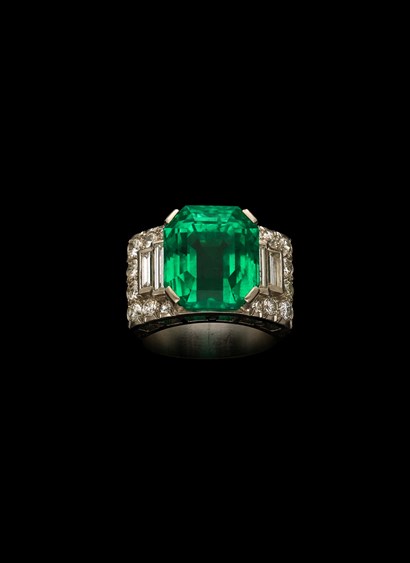
Pauline's Jewellery Box
Art Deco emerald & diamond ring, circa 1920-1930 Platinum, emerald and diamond Provenance: New York collection An Art Deco emerald & diamond ring, set with a step cut Colombian emerald weighing 10.87 carats flanked by baguette shaped & old mine cut diamonds. The emerald has a deep colour and is minor oil. Estimated total diamond weight is approximately 1.55 carats. Estimated colour E-G on average. Estimated clarity VVS-VS on average. The diamonds are bright & lively. Mounted in platinum. Accompanied by a SSEF certificate for the emerald.
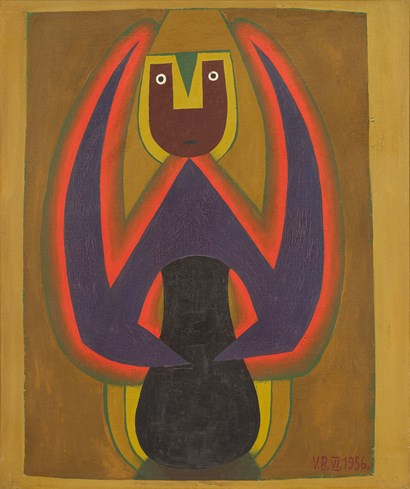
Galeria Jordi Pascual
Victor Brauner (Romania, Piatra Neamt 1903-1966 Paris, France) Frémissement, 1956 Oil on canvas 54.5 x 46 cm Signed and dated lower right This work is accompanied by a photo-certificate of authenticity issued by Samy Kinge, Paris, in 2025 Provenance: Galleria Lorenzelli, Bergamo; private collection, Italy
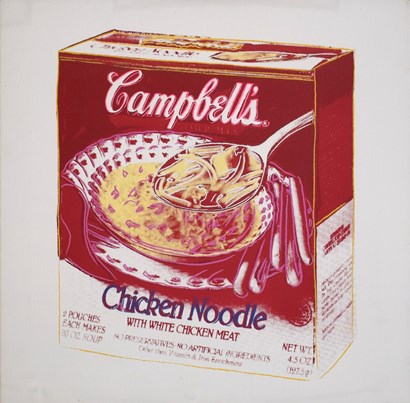
Gilden's Art Gallery
Andy Warhol (Pittsburgh 1928-1987 New York) Campbell's Chicken Noodle Soup Box, 1986 Acrylic and ink on canvas 50.8 x 50.8 cm Signed in felt tip pen 'Andy Warhol' and dated '86' [1986] on the upper canvas overlap, verso Stamped by the Andy Warhol Authentication Board and numbered in ballpoint pen A104.056, on the lower canvas overlap, verso Provenance: Michael Kohn Gallery, Los Angeles; private collection, Arizona; Van de Weghe Fine Art, New York; Demisch Danant, New York; private collection, Atlanta; Sotheby’s New York, May 13th, 2010, lot 191; private collection, Hong Kong; Christie’s Shanghai, September 21st, 2019, lot 310; private collection, Asia Literature: exh. cat. (1986), Warhol. Campbell’s Soup Boxes 1986, Michael Kohn Gallery, Los Angeles, reference n° 153, pp. 19, 30, ill. in colour

Objects With Narratives
ben storms
Ben Storms (Ghent, 1983) Ex Hale coffee table, 2024 Miel onyx H 32 x W 180 x D 90 cm Provenance: the artist's studio Ex Hale is a marble table that mimics the shape of a monumental cushion, resulting from a transformation of materials. Two metal sheets are blown up with the same technique that Ben Storms first used for his In Vein and In Hale tables. The resulting cushion shape is then scanned in 3D, after which a CNC machine mills the same shape from a block of marble. Ex Hale plays with our common notions of materiality: the hard stone looks soft instead, an impression that is further enhanced by the delicate surface treatment.
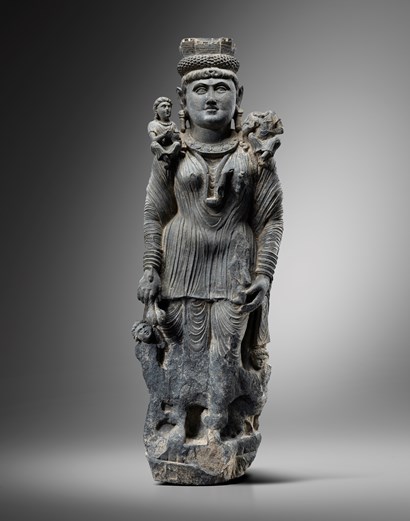
Grusenmeyer-Woliner
Hariti, the Buddhist protectress of children Ancient region of Gandhara, Swat Valley, 3rd-4th century AD Grey schist stone H 125 cm Provenance: European private collection, before 1990 (by reputation); an important private collection, Japan, by 1990 Literature: I. Kurita. Gandharan Art, vol. II, Tokyo, 1990, p. 169, fig. 493; M. Akira. Gandharan Art and Bamiyan Site, Tokyo, 2006, p. 114, n° 86 Hariti, the Buddhist protectress of children Imbued with an aura of maternal guardianship, Hariti was originally a yakshi who devoured children to sustain her own large family. Converted by the Buddha into their protector, she is depicted in Graeco-Buddhist art of the ancient Gandhara region surrounded by children. Perhaps the most prominent female deity in Gandhara, Hariti embodies fertility, wealth, and maternal care. She assumes a commanding stance, offering protection to mothers and infants. Draped in a clinging tunic that reveals a robust, fecund body, she is accompanied by children at her feet and shoulders, while a fifth child once hung from her left breast, of which only fragments remain. Her distinctive headdress represents the fortified walls of a city, a motif also associated with Tyche/Fortuna, the Greco-Roman guardian of cities, thereby reflecting the syncretism of Buddhist and Greco-Roman iconography. A wealth-bestowing goddess, she is richly adorned with jewellery - a necklace, collar, substantial earrings, and a pair of coiled serpentine armlets, a favoured motif in Graeco-style ornamentation. The present large-scale figure is exceptionally rare in private hands and was published in the seminal Japanese study on Gandhara art, widely known within collectors’ circles as the Kurita, which adds significantly to its prestige and desirability.
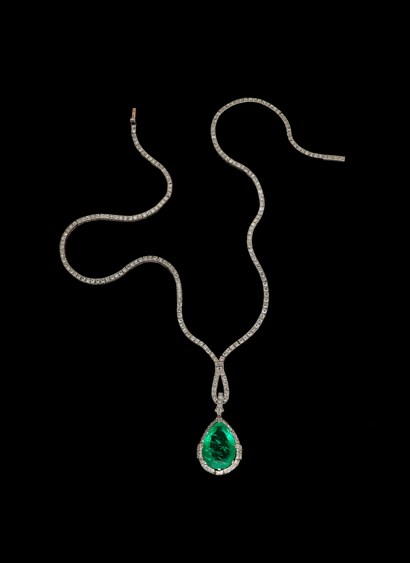
Pauline's Jewellery Box
Art Deco emerald & diamond necklace, circa 1920-1930 Platinum, emerald and diamond Provenance: France A beautiful Art Deco Colombian emerald & diamond pendant necklace, set with a pear shaped Colombian emerald weighing approximately 13.44 carats surrounded by old mine cut diamonds. Estimated total diamond weight is approximately 3.00 carats. Estimated colour H-I on average. Estimated clarity VS on average. The diamonds are bright & lively. Mounted in platinum.
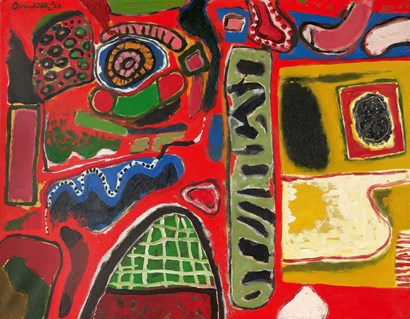
De Zutter Art Gallery
corneille
Corneille (Liège 1922-2010 Auvers-sur-Oise) Le rouge iténéraire de l'été, 1964 Oil on canvas 73 x 92 cm Provenance: Galerie Delta, Rotterdam; kunsthandel Lambert Tegenbosch, Heusden; collection Dr. Johan B.W. Polak (1928-1992), Amsterdam; Christie's, Amsterdam, 10 December 1992, lot n° 325; private collection, Switzerland Literature: Catalogue Galerie Cimaise Bonaparte (Patrick d'Elme and Daniel Templon), 1967, Paris Exhibition: Galerie Cimaise Bonaparte (Patrick d'Elme and Daniel Templon), 1967, Paris
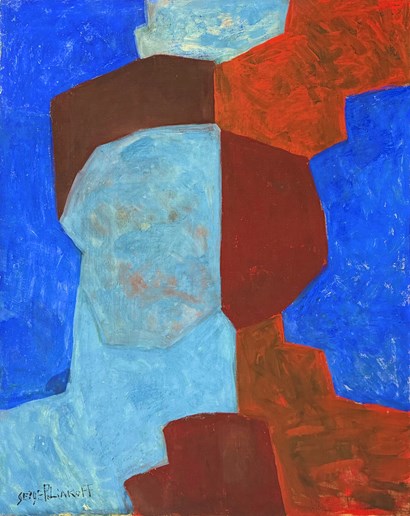
Galeria Jordi Pascual
Serge Poliakoff (Moscow 1900-1969 Paris) Abstract Composition, 1967 Oil on canvas 92 x 73 cm Signed lower left This work includes a photo-certificate of authenticity issued by the archives Serge Poliakoff in 2024 Provenance: Studio Bellini, Milan Literature: Poliakoff, Alexis. 'Serge Poliakoff – Catalogue Raisonné'. Volume V, 1966-1969. Munich 2016. p. 236, No. 67-101

Floris van Wanroij Fine Art
jan josefsz. van goyen
Jan Josefsz. van Goyen (Leiden 1596-1656 The Hague) Winter landscape with skaters, elegant figures and kolf players on the ice in a village Oil on panel 13.6 x 26.8 cm Signed and indistinctly dated lower left ‘I.V. GOYEN. 162.‘ Provenance: anonymous sale, Drouot, Paris, 21 March 1874, lot 23 (Frs. 510), erroneously as a pendant to the consecutive lot; collection Comte de Camondo, Galerie Georges Petit, Paris, 1 February 1893, Lot 6 (Frs. 1.700), were acquired by W. Gretor; anonymous sale, Drouot, Paris, 18 February 1895, Lot 13 (Frs. 750), were acquired by Lange; collection G. Forbes, London (according to Dayot and Hofstede de Groot); sale Jules Cronier, Galerie Georges Petit, Paris, 11 March 1908, Lot 88 (Frs. 1,200); with Kleinberger, Paris; collection Eugène Max, Paris, from 1911 to 1927; Grange, Paris; private collection, Paris, from 1965; anonymous sale, Sotheby’s, London, 1 March 1992, lot 36 (£ 101,200); John Mitchell, London, from 1993; anonymous sale, Christie’s, Amsterdam, 20 November 2012, lot nr. 68 (211.000 Euro); Johnny van Haeften Ltd., London, from 2014 (ref. VP4577), acquired from the previous owner; private collection, The Netherlands Literature: Dayot, A. (1911), Grands & petits maîtres hollandais, exhibition publication, Paris, n° 42; Martin, W. (1918), Alt-Holländische Bilder, Berlin, p. 51, fig. 25; Hofstede de Groot, C. (1927), A catalogue raisonné of the works of the most eminent Dutch painters of the seventeenth century, London, Vol. VIII, p. 294, n° 1170; Beck, H.-U. (1972), Jan van Goyen 1597-1656, Amsterdam, Vol. II, p. 46, n° 88 (illustrated, erroneously as a pendant to n° 244) Exhibitions: Paris, Salle du Jeu de Paume, Grands & petits maîtres hollandais, 28 April-10 July 1911, n° 40 bis; TEFAF Maastricht, 2014

Heutink Ikonen
Christ, the fiery eye Russia, Moscow Early 16th century 32 x 25.5 cm The name 'Christ, the fiery eye' is based on a text from Mark: 'He looked at them angrily, but also deeply saddened by their stubbornness.' Whether you, as a viewer, think that this Christ really looks grim is not only dependent on what the painter wanted to emphasise in the icon. It also has to do with the viewer's relationship to the person of Christ. There are several explanations for the origin of this iconography, for example that a mosaic from the Chora Church in Constantinople (Istanbul) served as its source.

Galerie Alexis Pentcheff
Regency period frame France, 18th century Carved oak, gilded with gold leaf 112.5 x 146 cm (sight size) Provenance: Montanari collection Sand-textured background decorated with acanthus scrolls, small flowers, drops, shells, and padded cartouches. Openwork acanthus leaves overflowing with playful movement in the corners.

